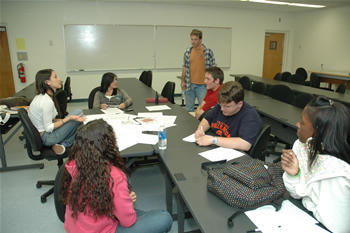Classroom 'Rocks and Rolls' With Volcano Simulation
Students learn how to prepare for a real-life volcanic event and their class lessons culminate with the mock eruption and role-playing scenario
November 7, 2006
By Debra Cano Ramos
Imagine you are part of the scientific team trying to figure out what to do as a volcano erupts, spewing hot lava, ash plumes and potentially poisonous gases in the air — and threatening the lives of millions of people nearby.
It’s pure chaos as you try and figure out the constant stream of data and information about things such as the amount of gas emissions in the air, the number of earthquakes taking place, all while having to contemplate major decisions of whether to order evacuations.
That’s what 60 freshman students did on Oct. 19, when they participated in a mock volcano simulation as part of their class studies. The students in the “Shake ’n Bake: Earthquakes & Volcanos” course — team taught by geological faculty David Bowman and Diane Clemens-Knott — began learning about how to prepare for a real-life volcanic event the first week of classes, and their class lessons culminated with the mock eruption and role-playing scenario.
|
The drill simulated a major eruption of a real volcano, the Guagua Pichincha volcano above Quito, the capital of Ecuador. For the exercise, students were broken into five to six-person “Volcano Disaster Assistance Program” (VDAP — a real program of the United States Geological Survey) groups that reacted to situation data provided via two actors: Mike VanRy, a geology major, and Daralyn Schoenewald, a student from last semester’s course. VanRy and Schoenewald acted out the roles of mayor, concerned townspeople and the press for the duration of the exercise. For the simulation, students had to work on their own and make decisions without help from the instructors, said Bowman.
“They learned a real-life scientific lesson,” he said. “They learned how difficult it is to predict an eruption and they learned how scientists estimate hazards such as lava, ash and volcanic mud flow.
“We apply pressure to them in the simulation; they have the fate of millions of people in their hands and they have to make the right decisions.”
|
The seismologist added that the complaints he heard from some students about the frustrations and difficulties of trying to predict a volcano’s eruption and dealing with the fall out meant that the exercise worked and was successful.
“The point of the simulation is to make them realize the vast uncertainties of the real world.”
|
Clemens-Knott, chair and professor of geological sciences, and Bowman, associate professor of geological sciences first taught the course last year.
The goal, Bowman explained, is to give students an exciting and first-hand look at geosciences — and what the discipline has to offer. The hope, he added, is to get students interested in majoring in geological sciences.
|
Photos by Patrick O'Donnell






 Produced by the Office of Public Affairs at California State University, Fullerton.
Produced by the Office of Public Affairs at California State University, Fullerton.